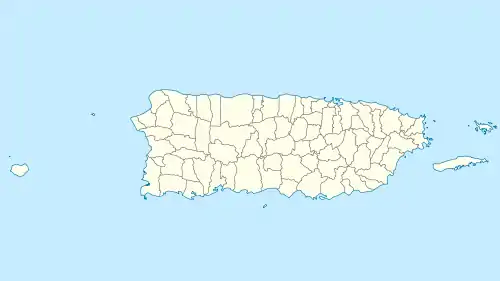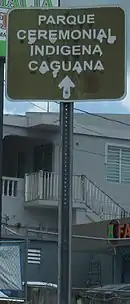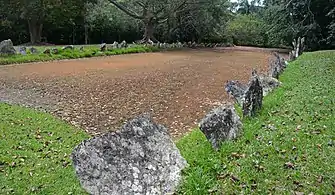Caguana Ceremonial Ball Courts Site
The Caguana Ceremonial Ball Courts Site in Caguana barrio, Utuado, Puerto Rico,[4] is considered, by archeologists, one of the most important archeological sites in the West Indies.[5]
Caguana Ceremonial Ball Courts Site | |
 Taíno ball courts at Caguana Site | |
 Caguana Ceremonial Ball Courts Site Location of the Caguana Site in Puerto Rico | |
| Location | Highway 111, Km 12.3 Utuado, Puerto Rico |
|---|---|
| Coordinates | 18°17′42″N 66°46′52″W |
| Area | 7 acres (2.8 ha)[1] |
| Built | Around 1270 AD |
| NRHP reference No. | 92001671[2] |
| Significant dates | |
| Added to NRHP | December 17, 1992 |
| Designated NHL | November 4, 1993[3] |
Studies estimate it is over 800 years old, built by the Taíno around 1270 AD. Approximately 30 ball courts (bateyes) have been identified and many have been restored to their original state. The game of batey is believed to have originated in Mesoamerica and is said to have been played in Cuba, Jamaica, Hispaniola, the Bahamas and the Virgin Islands.[6] Monoliths and petroglyphs carved by the Taínos can be seen among the rocks and stones, some weighing over a ton, that were most likely brought from the Tanama River located adjacent to the site. Also located near the site is the Cemí Mountain (Montaña Cemí) which was believed, by the Taínos, to be the home of their gods and the reason they built the ball courts in that area.
The Caguana Site most likely served several different functions. First it was used for ceremonial dances, religious rituals and other rites; it was used for playing ball games in which two teams of equal numbers tossed a ball to each other; and third, it is believed to be used to make astronomical observations.

The Institute of Puerto Rican Culture manages the site as a park under the name Caguana Indigenous Ceremonial Center (Parque Ceremonial Indígena de Caguana). The National Park Service has placed it on the National Register of Historic Places, and designated it as a National Historic Landmark (under the name Caguana Site).
The park also includes a small museum containing Taíno artifacts, archaeological exhibits and a botanical garden featuring the plants the Taínos harvested for food, such as sweet potatoes, cassava, corn, and yautía. Many of the trees used by the Taínos to construct their homes (bohíos), such as mahogany and ceiba can be seen throughout the park.
It was listed on the National Register in 1992 and designated a U.S. National Historic Landmark in 1993.[3][2][1]
Gallery
 Ball Court
Ball Court Bird drawn on stone
Bird drawn on stone Faces drawn on stones
Faces drawn on stones Traditional Bohio like the ones built by the Taino
Traditional Bohio like the ones built by the Taino
See also
References
- Mark R. Barnes (January 25, 1993). "National Historic Landmark Nomination: Caguana Ceremonial Ball Courts Site". National Park Service. and Accompanying four photos, from 1991
- "National Register Information System". National Register of Historic Places. National Park Service. April 15, 2008.
- "Caguana Site". National Historic Landmark summary listing. National Park Service. Archived from the original on 2007-12-06. Retrieved 2007-06-28.
- "Archived copy". Archived from the original on 2012-04-26. Retrieved 2018-11-16.CS1 maint: archived copy as title (link)
- "Parque Ceremonial Indígena de Caguana. Puerto Rico". pueblosoriginarios.com.
- "Caguana Ceremonial Ball Courts Site--Historic Places in Puerto Rico and the Virgin Islands; A National Register of Historic Places Travel Itinerary". www.nps.gov.
External links
 Media related to Caguanas Indigenous Ceremonial Center at Wikimedia Commons
Media related to Caguanas Indigenous Ceremonial Center at Wikimedia Commons- National Park Service Images
- Additional National Park Service Images
- Centro Ceremonial Indígena de Caguana, Utuado - Puerto Rican Cultural Institute
- National Park Service site description for visitors
- National Historic Landmark description by the National Park Service
- Parque Ceremonial Indigena de Caguana Official Page
- Summary sheet from the Puerto Rico State Historic Preservation Office (in Spanish)
